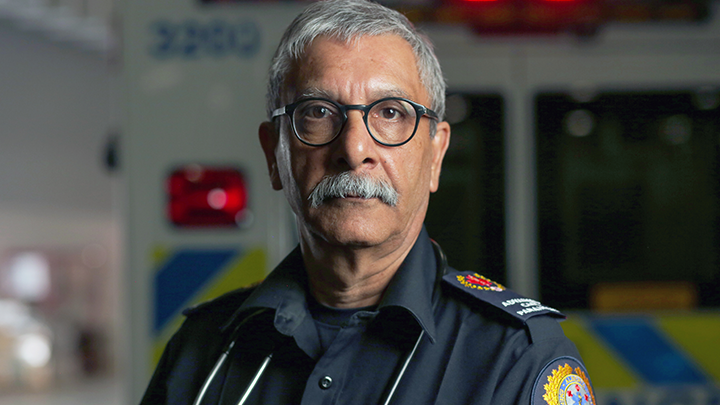
May 28, 2019

Rajnikant ‘Raj’ Dattani has been an AHS Advanced Care Paramedic for more than 41 years. As retirement looms, he says he’ll miss the excitement of his EMS career.
By Erin Lawrence | Photo by Leah Hennel
CALGARY — In this day and age, spending 41 years on the job is an anomaly. Spending 41 years loving your job is even rarer.
Rajnikant ‘Raj’ Dattani is an Advanced Care Paramedic for Alberta Health Services, and has been for more than four decades. His job has been to respond to emergency calls, arrive on the scene, assess what’s needed, then do what’s best for the patient. He’s currently based out of Calgary’s EMS Stone Gate headquarters.
Before he got up to speed rolling in an ambulance, however, he rode the rails, where he discovered his love for medicine, learning and working with people.
“I started out working for Canadian Pacific Railway. One day I burned my hand on some hot steel and had to go visit the first aid room,” Dattani recalls. “He fixed me up and I thought, ‘How great is that to be able to help people like that?” So right then I decided to sign up for a St. John’s Ambulance Course to learn first aid for myself.”
Dattani came to Canada as a refugee in 1972, escaping the brutal dictatorship of Uganda’s Idi Amin, one of many families who fled during the regime.
Only 22 at the time, he recalls: “I went from prince to pauper. I saw some terrible things. But Canada opened its doors to us.”
After first settling in Vancouver, he relocated to Calgary to be closer to his brother. In time, he met his wife, and they raised two children.
His difficult youth, however, had taught him some life lessons — and the value of compassion, empathy, and respect for human life.
“A good paramedic is humble. You can’t just go in there with your uniform on and try to take over. You have to be compassionate; some people see a uniform and they’re afraid,” he says, recalling his brushes with Uganda’s military rulers.
“You have to let them know you’re there to help, and go in with respect and treat people with dignity, no matter who they are or what problem they might have called us for.”
Dattani is living proof that it’s possible to enjoy a long and extremely rewarding career as a paramedic, but you have to have a positive attitude and you’ve got to love people. It also helps to realize your training will likely put you in some unusual situations.
“In 1992 I was on an Air Canada flight with my family. Back before the days of rigid security, a passenger got up and all of a sudden grabbed a coffee pot and threw hot coffee all over a couple rows of passengers. People were hurt and I knew I had to do something, especially when she grabbed a knife next.”
Dattani says he swooped in and rallied another passenger to help him subdue the woman. The captain came back to find the passengers, including Dattani, had successfully used zip ties to restrain the woman from doing further damage, but even so, the pilot was prepared to divert the plane.
Dattani convinced him to continue with the flight, with a promise to assist the scalded passengers while, at the same time, to keep the unruly passenger in check. Dattani later received an award for his efforts.
Later this summer, Dattani will hang up his stethoscope as a paramedic.
While he admits he’ll miss the day-to-day excitement of never knowing what the day will bring — he’s ready for a mellower change of pace, and plans to devote more time to garden, cook and spend time with his loved ones.
“For anyone thinking of becoming a paramedic, it’s a great career,” he says. “If you’re going to do it, decide to be the best at it. Be humble, and kind and have a great attitude. It helps if you’re really a people person.”
Dattani sums up his job with a sweet bit of philosophy: “He who saves the life of one man saves the world.”